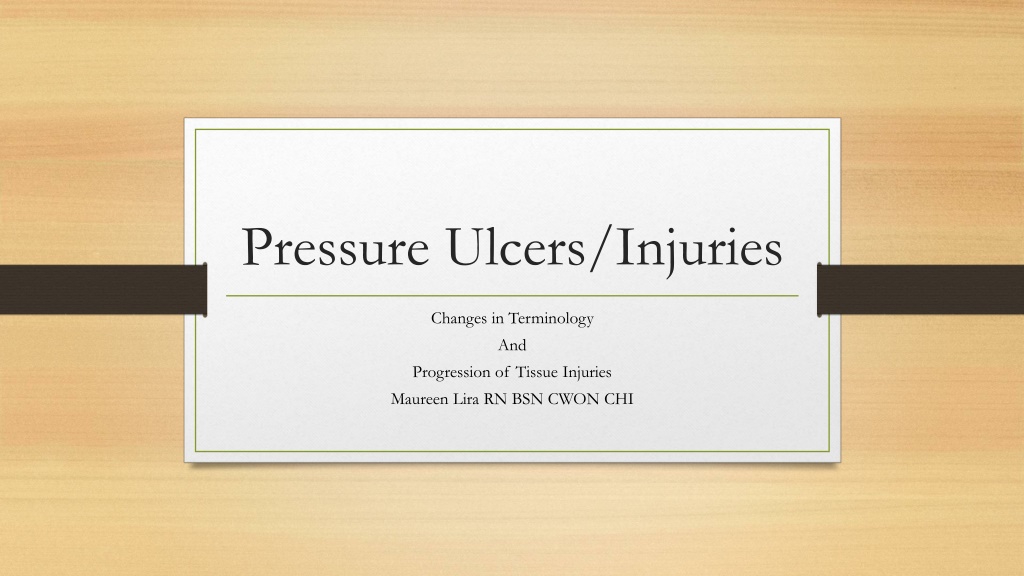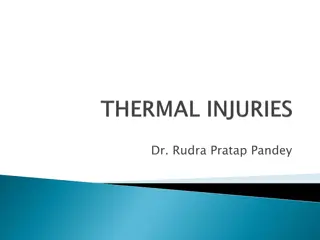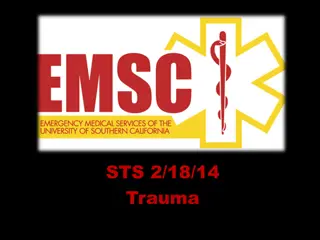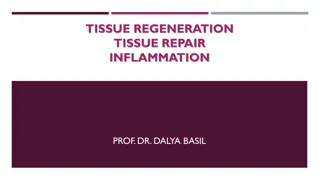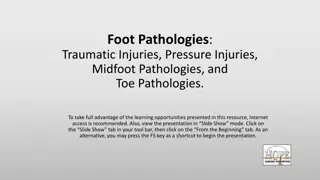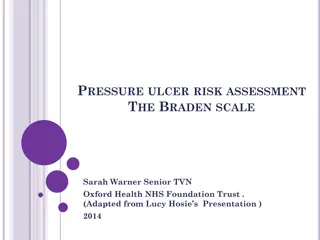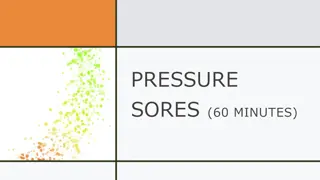Understanding Pressure Ulcers and Tissue Injuries Progression
Pressure ulcers, also known as pressure injuries, are localized damages to the skin and underlying soft tissue usually over bony prominences. The National Pressure Ulcer Advisory Panel changed the terminology in 2016 to classify all stages as injuries, not just ulcers. Stages range from non-blanchable erythema in Stage 1 to full-thickness loss of the dermis in Stage 3 and exposure of underlying structures in Stage 4. Understanding the terminology and progression of pressure injuries is crucial for accurate assessment and treatment.
Download Presentation

Please find below an Image/Link to download the presentation.
The content on the website is provided AS IS for your information and personal use only. It may not be sold, licensed, or shared on other websites without obtaining consent from the author. Download presentation by click this link. If you encounter any issues during the download, it is possible that the publisher has removed the file from their server.
E N D
Presentation Transcript
Pressure Ulcers/Injuries Changes in Terminology And Progression of Tissue Injuries Maureen Lira RN BSN CWON CHI
What is a Pressure Ulcer/Injury? A pressure injury is localized damage to the skin and underlying soft tissue usually over a bony prominence or related to a medical or other device. The injury can present as intact skin or an open ulcer and may be painful. The injury occurs as a result of intense and/or prolonged pressure or pressure in combination with shear. The tolerance of soft tissue for pressure and shear may also be affected by microclimate, nutrition, perfusion, co-morbidities and condition of the soft tissue. Staging describes depth of damage
National Pressure Ulcer Advisory Panel NPUAP has been the authority in writing definitions of pressure ulcer stages Added Unstageable and Deep Tissue stages in 2007 Most recently in April 2016, terminology was changed to indicate all stages are INJURIES, but not are ULCERS Concerns changing over to new terminology : pre printed forms, pull down menus in software, coding with old terminology
Stage 1 Pressure Injury Non Blanchable Erythema to INTACT skin Color changes do not include purple or maroon discoloration; these may indicate deep tissue pressure injury. Localized, not a generalized area measurements verify this Not a real ulcer since skin is still intact
Pressure Injury Stage 2 New definition includes what a stage 2 is NOT medical adhesive tissue damage, incontinence dermatitis, or traumatic wounds Also includes what the wound bed does not have ( devital tissue ) slough, eschar Lastly, what is not SEEN in wound bed adipose, granulation tissue
Stage 3 Pressure Injury Full thickness loss dermis is no longer present Many Characteristics MAY be found though do not have to be Adipose, granulation tissue, slough ( not obscuring depth ) tunneling, undermining, epibole Differ from stage 4 and unstageable non obscuring slough/eschar ( unstageable ) muscle, tendon, bone, ligament, fascia ( stage 4 )
Stage 4 Pressure Injury Exposed or directly palpable structures bone, muscle, fascia, tendon, ligament Takes over where stage 3 left off Definition still warns of describing eschar obscuring depth as unstageable rather than 3 or 4
Unstageable Pressure Injury Taking from definitions in Stage 3 and 4 Cannot see depth of wound due to eschar or slough If removed, would be stage 3 or 4 Here is the trick if an unstageable is documented as a stage 3 and when eschar is removed, bone is exposed, it APPEARS to have deteriorated to a stage 4 when the damage was already done Same idea with an unstageable which is revealed to be stage 3 if documented as 4 , there are no structures to verify this ( excisional debridement as example )
Deep Tissue Pressure Injury Dark INTACT tissue may open up and staging remains the same Staging changes when assessment fits another stage s description The wound may evolve rapidly to reveal the actual extent of tissue injury, or may resolve without tissue loss. Evolution is the key it is not deteriorating this is expected
Evolution, Resolution and Deterioration Deterioration Stage 2,3, 4 or Unstageable Stage 3, 4 or Unstageable Stage 1 2 Resolution No longer red Healed/ open ulcer closed Healed/open ulcer closed Healed/open ulcer closed Healed/open ulcer closed possible Evolution none Blister to open ulcer Stage 1 or 2 may heal rapidly or linger even with interventions if the patient has no ability to heal ( RESOLVE ) Stage 1, 2 or 3 4 - indicates DETERIORATION Stage 1 or 2 unstageable partial thickness to full thickness DETERIORATION Stage 3 can become unstageable and may or may not indicate deterioration Unstageable and deep tissue pressure injury stage 3 or 4 NOT deterioration Deep tissue Damage already done 3 Stage 4 Could become unstageable Could become unstageable Will become stage 3 or 4 4 None Unstageable If initially stage 3 , becomes a 4 Stage 3 or 4
Challenges MD s do not always stage correctly Excisional debridement level of healthy tissue may not correlate with staging definition Deep tissue pressure injury uses unstageable code resolve vs evolve Different etiologies wound care nurse may document one etiology and MDs and nurses document pressure
Summary Terminology of Stages changed by NPUAP Not yet updated in ICD 10 s Evolution of injury vs deterioration Many clinicians documenting may not be consistent with one another Questions ?
References NPUAP website, http://www.npuap.org/resources/educational-and-clinical- resources/npuap-pressure-injury-stages/. Obtained January 18th, 2017
